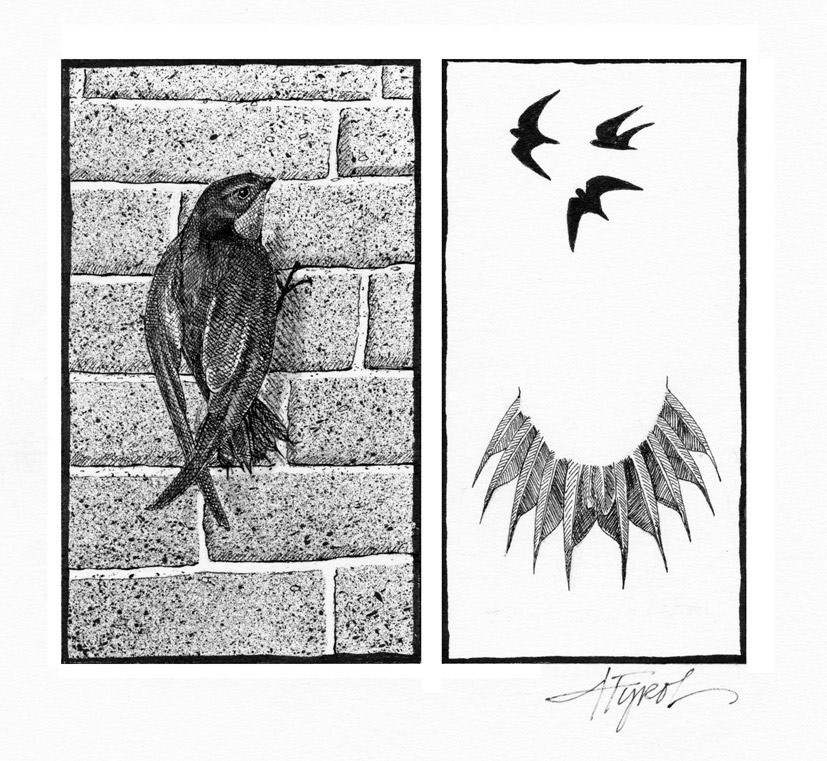
Darting through the air while twittering in constant conversation, chimney swifts are a cheering presence over many cities and towns. True to their name, which comes from the Old English swifan – “to move in a course, sweep, or revolve” – these loquacious birds etch great circles overhead, emerging at daybreak and continuing until they flutter down the chimney at dusk.
But swifts didn’t always roost and nest in chimneys. Hollow trees were their natural habitat, especially trees in which the inside had rotted away following a lightning strike.
Few species have become so completely dependent on human-made structures for their existence. Laura Erickson, science editor at the Cornell Laboratory of Ornithology, says, “Chimney swift populations increased dramatically with the arrival of European settlers and the construction of chimneys. Brick chimneys are ideal for swifts to perch in.”
The first record of swifts nesting in chimneys dates to 1672, but swifts continued nesting in trees as well. In 1840 John James Audubon reported a colony of roughly 9,000 swifts living in a hollow sycamore tree.
Being one of just four species of North American swifts, our native chimney swift is a soot-colored bird that breeds east of the Rocky Mountains in the U.S. and southern Canada. Flying by daylight—their 5-inch bodies carried aloft on strong, stiff wings that span 12 inches—chimney swifts migrate northward in spring after wintering in northwestern and north-central South America.
Swifts return when insects emerge en masse in late April. Rapacious predators that can consume one third of their weight each day, swifts circle overhead and devour any insect that’s small enough to eat, including thousands of mosquitoes and other pests that would otherwise bite or sting us or consume our gardens and ornamentals.
These indefatigable birds never land, except to roost at night. When moved by the mating urge, they circle in small groups, ramping up their speed and level of chatter. Consummation lasts but a few seconds while the male raises his wings and makes contact with the female in mid-air.
In northern New England, swifts make their nests in late May, using small twigs that they snap off with their feet while in flight. The swift then transfers each twig to its mouth and uses mucilaginous saliva to glue it into a half-nest that adheres to the chimney wall. Both sexes build the nest. Although sharp claws and bristly tails help them to cling to vertical surfaces, swifts cannot perch on a branch or even stand on a flat surface. Nests are constructed from near the top of a chimney to more than 20 feet down the flu. Occasionally, swifts will nest in cisterns and silos, along barn walls and even in outhouses.
Each tiny nest soon holds 4 to 5 pure-white eggs, which hatch in 18 to 19 days. A month after hatching, the fledglings climb to the top of the chimney and take to the sky. Breeding pairs only raise one brood each year. In early August, swifts congregate in anticipation of the journey south.
That is our favorite time to watch swifts, when their tireless flights teach young birds the secrets of survival and reinforce their ebullient nature. Swifts create one of the greatest spectacles of nature to be seen in our own neighborhoods. At dusk they swirl above the roosting chimney to form a living avian funnel. Each bird circles until just the right moment, when it lifts up its wings, angles its tail, and checks its flight to gently flutter down the flu. (One enormous colony inhabits the chimney at the middle school on South Street in Claremont, New Hampshire.)
Swifts are so fast and facile – veering and darting along paths that are hard to follow –that they have few predators, save the occasional sharp-shinned hawk or other agile bird of prey.
Although a late-spring chill can occasionally wipe out the swift’s essential insect food for a time, people pose a far greater threat. When a fire is built in a chimney with a nest, the heat and smoke can wipe out an entire colony of hundreds or thousands of birds.
Modern chimneys can also be a problem, as Cornell’s Laura Erickson observes. “Populations of chimney swifts have declined throughout their range as metal-lined chimneys have replaced their brick counterparts. There’s nothing to hang onto inside a metal-lined chimney. Even new brick chimneys have liners that chimney swifts can’t hang on to.”
If you have a masonry chimney, you can manage the flu to make it safe for swifts. Clean the chimney after the wood-burning season, keep the top open from late April to early September so swifts can gain access, and don’t light fires when they’re around. If you’re really motivated, you can obtain plans for building a swift nesting tower at: www.chimneyswifts.org.


Discussion *